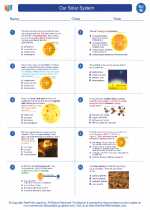Our Solar System -> convective motion
Convective Motion
Convective motion refers to the movement of fluids (liquids and gases) as a result of variations in temperature and density. This type of motion occurs in the Earth's atmosphere, oceans, and even in the mantle beneath the Earth's crust. The driving force behind convective motion is the transfer of heat, which causes the fluid to expand and become less dense, leading to upward movement. As the fluid moves to regions of lower temperature, it cools and becomes denser, causing it to sink back down. This circulation pattern creates a continuous cycle of motion.
Key Concepts to Understand Convective Motion:
- Heat Transfer: Convective motion is driven by the transfer of heat. When a fluid is heated, it becomes less dense and rises, while cooler, denser fluid sinks.
- Density Variations: Variations in temperature lead to changes in fluid density, which in turn drive convective motion.
- Atmospheric Convection: In the Earth's atmosphere, convective motion is responsible for the formation of clouds, thunderstorms, and the distribution of heat and moisture.
- Oceanic Convection: In the oceans, convective motion influences the circulation of water, nutrient transport, and the distribution of heat, playing a crucial role in the Earth's climate system.
- Mantle Convection: Convective motion in the Earth's mantle is linked to plate tectonics and the movement of Earth's crustal plates.
Study Guide:
To better understand convective motion, consider the following study topics:
- Properties of Fluids: Understand how temperature and density variations affect the behavior of fluids.
- Fluid Dynamics: Study the principles of fluid flow, including the factors influencing the movement of fluids.
- Atmospheric Circulation: Explore the mechanisms behind air movement in the Earth's atmosphere and its impact on weather patterns.
- Ocean Currents: Investigate the causes and effects of oceanic convection, including the role of currents in distributing heat and nutrients.
- Plate Tectonics: Examine the connection between mantle convection and the movement of Earth's tectonic plates.
By delving into these topics, you can gain a comprehensive understanding of convective motion and its significance in various natural systems.
.◂Science Worksheets and Study Guides Eighth Grade. Our Solar System

 Worksheet/Answer key
Worksheet/Answer key
 Worksheet/Answer key
Worksheet/Answer key
